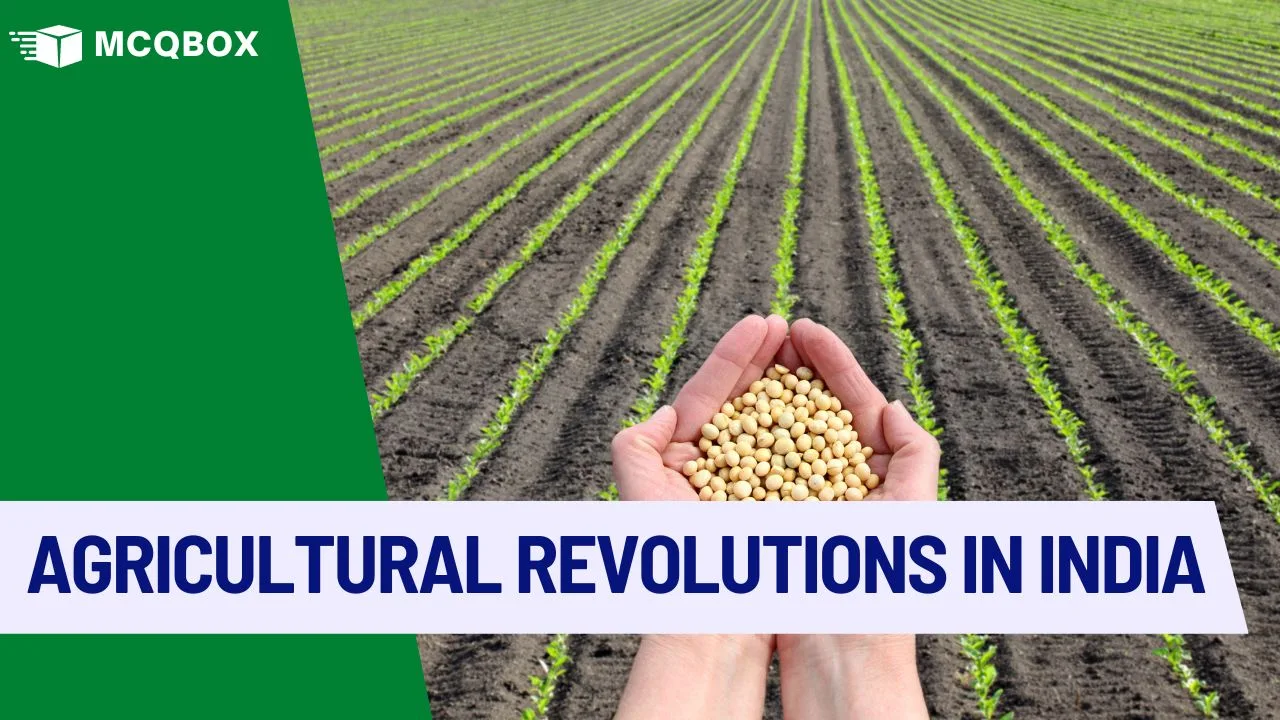List of all Agriculture Revolutions in India (1960-2023)
Table of Contents

Green Revolution:
It was initiated in the 1960s, focused on high-yielding variety seeds, irrigation, and chemical fertilizers, significantly boosting wheat and rice production.
White Revolution:
Launched in the 1970s, aimed at dairy development, led to increased milk production through cooperative efforts like Operation Flood.
Yellow Revolution:
Concentrated on oilseed production, aiming for self-sufficiency in edible oil production.
Blue Revolution:
Centered on fisheries and aquaculture development, utilizing technology to enhance fish production.
Golden Revolution:
Emphasized the growth of horticulture, particularly fruits, and vegetables.
Silver Revolution:
Aimed to increase the production of pulses to meet the protein demand in the country.
Pink Revolution:
Focused on the meat and poultry industry, aiming to boost production and exports.
Evergreen Revolution:
Advocated sustainable agriculture practices like organic farming and conservation agriculture.
Silk Revolution:
Targeted the development of sericulture, particularly silk production.
Brown Revolution:
Utilized biotechnology to enhance cotton production.
Rubber Revolution:
Focused on increasing rubber production, particularly in states like Kerala.
Bamboo Revolution:
Aimed at boosting bamboo production and utilization, especially in the Northeastern states.
Sweet Revolution
Emphasized the development of honey production and its subsequent export.
Grey Revolution:
Concentrated on the fertilizer industry to ensure increased availability.
Red Revolution:
Focused on meat and tomato production, particularly notable in states like Maharashtra.
Golden Fiber Revolution:
Aimed at enhancing the production of jute and allied fibers, prominent in West Bengal.
Sugar Revolution:
Aimed to increase sugarcane production, notable in states like Uttar Pradesh.
Silver Fiber Revolution:
Focused on cotton and man-made fiber production, particularly significant in Maharashtra.
Questions and Answers on Indian Agriculture Revolutions
1. When did the Green Revolution start in India?
Answer. 1960s
2. What were the main crops focused on during the Green Revolution?
Answer. Wheat, rice
3. Which Indian scientist is known as the “Father of the Green Revolution”?
Answer: MS. Swaminathan
4. What technology played a significant role in the Green Revolution?
Answer: HYV (High Yielding Variety) seeds
5. Which state was at the forefront of the Green Revolution in India?
Answer. Punjab
6. What impact did the Green Revolution have on agricultural production?
Answer: The Green Revolution significantly increased agricultural yields and output.
7. What challenges did the Green Revolution face?
Answer: The Green Revolution encountered environmental concerns due to increased chemical use, leading to soil degradation and water pollution. It also faced issues of unequal distribution of benefits, exacerbating socioeconomic disparities among farmers. Additionally, over-reliance on specific crops and technologies poses threats of vulnerability to pests and diseases.
8. Which organization played a crucial role in implementing the Green Revolution?
Answer: Indian Council of Agricultural Research (ICAR)
9. Name one limitation of the Green Revolution.
Answer: Dependency on chemical inputs was a significant limitation of the Green Revolution.
10. What is the significance of the White Revolution in India?
Answer. Dairy growth
11. Which year marked the beginning of the White Revolution?
Answer. 1970
12. Name the person associated with the White Revolution.
Answer. Dr. Verghese Kurien
13. Which state is known for the success of Operation Flood?
Answer. Gujarat
14. What was the main aim of Operation Flood?
Answer. Milk production
15. Which revolution focused on oilseed production?
Answer. Yellow Revolution
16. What crop was the focus of the Blue Revolution?
Answer. Fisheries
17. Name one factor leading to the success of the Blue Revolution.
Answer. Technology adoption in aquaculture contributed to the success of the Blue Revolution.
18. Which revolution emphasized the development of horticulture?
Answer. Golden Revolution
19. Name one crop associated with the Golden Revolution.
Answer. Fruits
20. Which revolution aimed to improve the production of pulses?
Answer. Silver Revolution